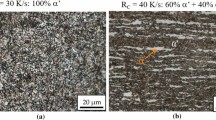Abstract
Regulation of the process parameters allows obtaining the required properties of the metal. A computer simulation of technological processes with allowance for structural and phase transformations of the metal forms the basis for the proper choice of those parameters. The purpose of the paper is to study the main diffusion and diffusion-free transformation processes in alloyed steels during heating and cooling using the methods of mathematical modeling. A comparative analysis of the kinetic equations of phase transformations including the Kolmogorov–Avrami and Austin–Rickett equations that describe in different ways the dependence of the diffusion transformation rate on the time and the attained degree of transformation is carried out. It is shown that the Austin–Rickett equation is equivalent to the Kolmogorov–Avrami equation with a smooth decrease of the Avrami exponent during the transformation process. The advantages of the Kolmogorov–Avrami equation for modeling the kinetics of ferrite-pearlite and bainite transformations and the validity of this equation for modeling the kinetics of martensite transformations during tempering are shown. The parameters for describing the tempering process of steel 35 at different temperatures are determined. The proposed model is compared with equations based on the Hollomon–Jaffe parameter. The diagrams of martensitic transformation of alloyed steels and the disadvantages of the Koistinen–Marburger equation used to describe them are analyzed. The equations of the temperature dependence of the degree of transformation, similar to the Kolmogorov–Avrami and Austin–Rickett equations, are derived. The equations contain the minimum set of the parameters that can be found from published data. An iterative algorithm for determining parameters of the proposed model providing the minimum rms deviation of the constructed dependence from the initial experimental data is developed. The dependence of the accuracy of approximation on the temperature of the onset of transformation is presented. The complex character of the martensitic transformation development in alloyed steels is revealed. The advantage of using equations of the Austin–Rickett type when constructing models with a limited amount of experimental data is shown. The results obtained make it possible to extend the approaches used in the modeling of diffusion processes of austenite decomposition to the description of the processes of martensite formation and decomposition in alloyed steels.






Similar content being viewed by others
REFERENCES
Kolmogorov, A.N., The statistical theory of crystallization of metals, Izv. Akad. Nauk SSSR, Ser. Mat., 1937, no. 3, pp. 355–359.
Austin, J.B. and Rickett, R.L., Kinetics of the decomposition of austenite at constant temperature, Trans. Am. Inst. Min., Metall., Petrol. Eng., 1939, vol. 135, pp. 396–443.
Kurkin, A.S. and Bobrinskaya, V.Yu., The austenite decomposition diagrams processing to build the complete C-shaped curves, Svarka Diagn., 2019, no. 2, pp. 32–37.
Starink, M.J., Kinetics of the decomposition of austenite at constant temperature, J. Mater. Sci., 1997, vol. 32, pp. 397–415.
Mirzayev, D.A., Okishev, K.Yu., Schastlivtsev, V.M., Mirzoev, A.A., Yakovleva, I.L., and Karzunov, S.E., Kinetics of ferrite formation in Fe–9% Cr alloys with various concentrations of interstitial impurities, Phys. Met. Metallogr., 1998, vol. 86, no. 6, pp. 590–600.
Mirzaev, D.A., Okishev, K.Yu., Schastlivtsev, V.M., and Yakovleva, I.L., Kinetics of the formation of bainite and packet martensite: I. Effect of the structure of packets, Phys. Met. Metallogr., 2000, vol. 90, no. 5, pp. 471–480.
Popov, A.A. and Popova, L.E., Izotermicheskie i termokineticheskie diagrammy raspada pereokhlazhdennogo austenita (Isothermal and Thermokinetic Diagrams of Supercooled Austenite Decomposition), Moscow: Metallurgiya, 1965.
Koistinen, D.P. and Marburger, R.E., A general equation prescribing the extent of the austenite-martensite transformation in pure iron-carbon alloys and plain carbon steels, Acta Metall., 1959, no. 7, pp. 59–60.
Bain, E.C., Functions of the Alloying Elements in Steel, Cleveland: Am. Soc. Met., 1939.
Hollomon, J.H. and Jaffe, J.H., Time-temperatures relations in tempering steel, Trans. Am. Inst. Min., Metall., Petrol. Eng., 1945, vol. 162, pp. 223–249.
Kurkin, A.S., Makarov, E.L., Kurkin, A.B., Rubtsov, D.E., and Rubtsov, M.E., Parameters of models of structural transformations in alloy steel under welding thermal cycle, Met. Sci. Heat Treat., 2017, vol. 59, no. 1, pp. 124–130.
Zhang, Z., Delagnes, D., and Bernhart, G., Microstructure evolution of hot-work tool steels during tempering and definition of a kinetic law based on hardness measurements, Mater. Sci. Eng., A, 2004, vol. 380, pp. 222–230.
Piekarska, W., Goszczyńska, D., and Saternus, Z., Application of analytical methods for predicting the structures of steel phase transformations in welded joints, J. Appl. Math. Comput. Mech., 2015, vol. 14, no. 2, pp. 61–72.
Yudin, Yu.V., Maisuradze, M.V., and Kuklina, A.A., Describing the isothermal bainitic transformation in structural steels by a logistical function, Steel Transl., 2017, vol. 47, no. 3, pp. 213–218.
Author information
Authors and Affiliations
Corresponding author
Ethics declarations
The authors declare that they have no conflicts of interest.
Additional information
Translated by N. Semenova
Rights and permissions
About this article
Cite this article
Kurkin, A.S. Mathematical Research of the Phase Transformation Kinetics of Alloyed Steel. Inorg Mater 56, 1471–1477 (2020). https://doi.org/10.1134/S0020168520150091
Received:
Revised:
Accepted:
Published:
Issue Date:
DOI: https://doi.org/10.1134/S0020168520150091




